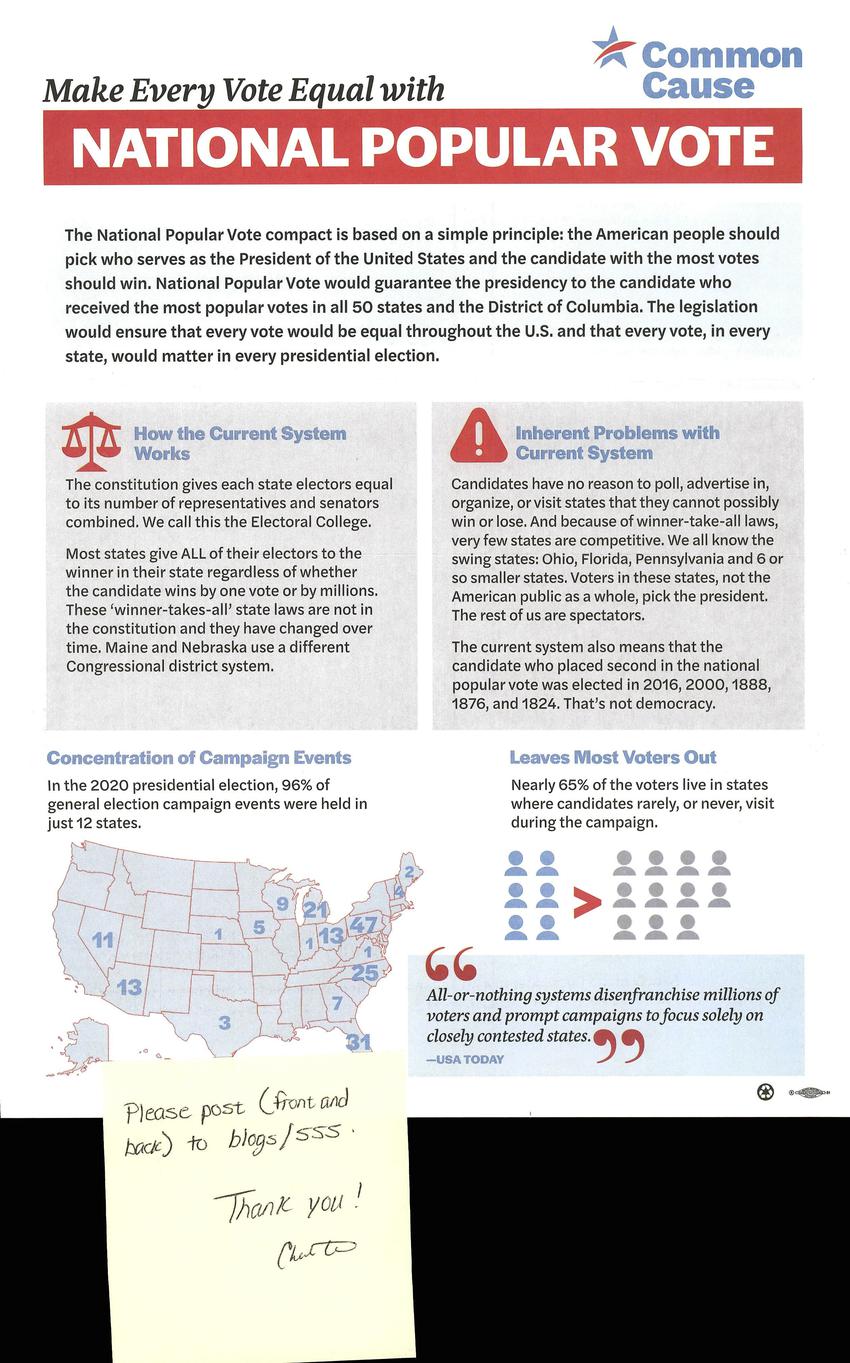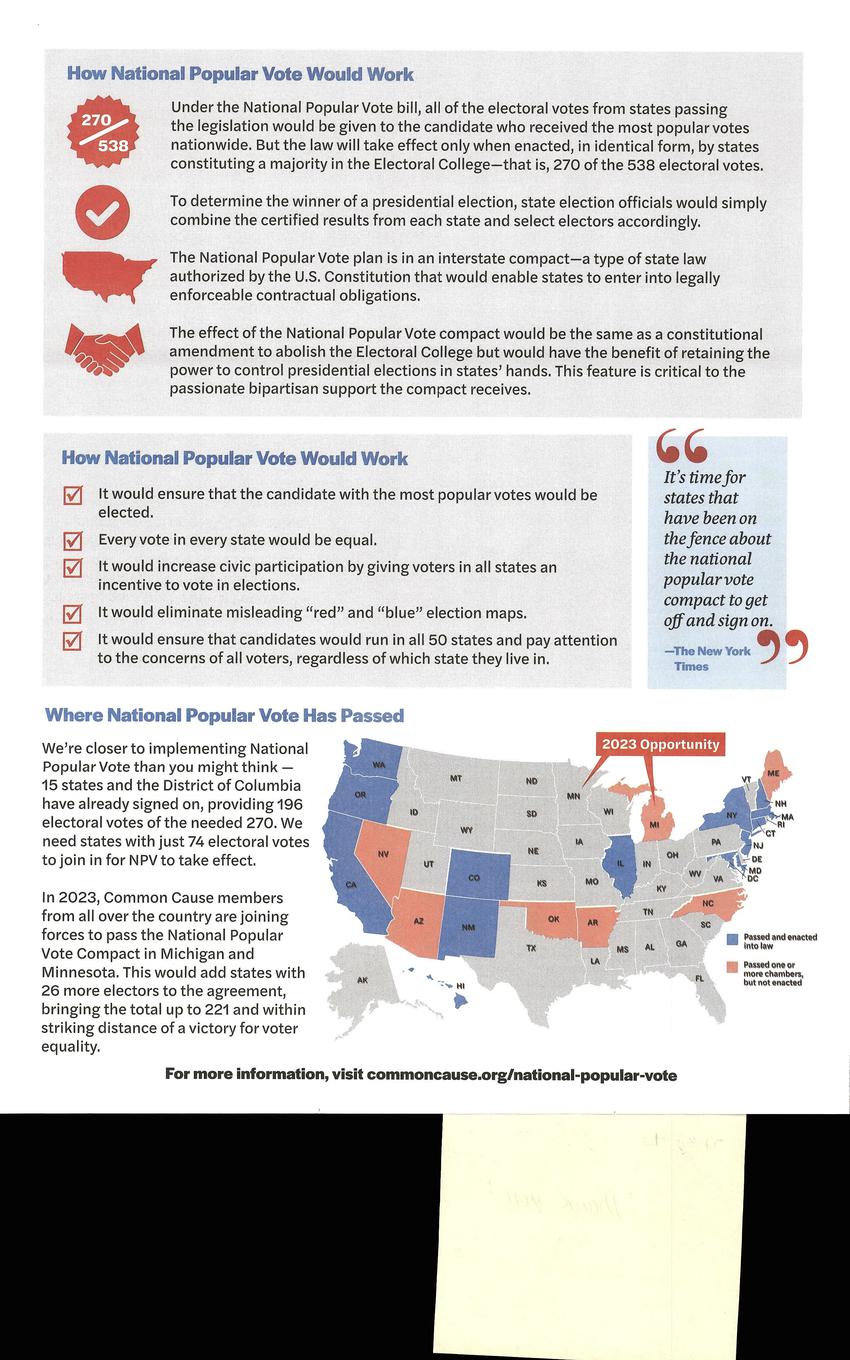
Transcription
https://www.commoncause.org/our-work/voting-and-elections/national-popular-vote/
Common Cause
Make Every Vote Equal With
National Popular Vote
The National Popular Vote compact is based on a simple principle: The American people should pick who serves as the President of the United States and the candidate with the most votes should win. National Popular Vote would guarantee the presidency to the candidate who received the most popular votes in all 50 states and the District of Columbia. The legislation would ensure that every vote would be equal throughout the U.S. and that every vote, in every state, would matter in every presidential election.
How The Current System Works
The constitution gives each state electors equal to its numbers of representatives and senators combined. We call this the Electoral College.
Most states give ALL of their electors to the winner in their state regardless of whether the candidate wins by one vote or by millions. These 'winner-takes-all' state laws are not in the constitution and they have changed over time. Maine and Nebraska use a different Congressional district system.
Inherent Problems with Current System
Candidates have no reason to poll, advertise in, organize, or visit states that they cannot possibly win or lose. And because of winner-takes-all laws, very few states are competitive. We all know the swing states: Ohio, Florida, Pennsylvania and 6 or so smaller states. Voters in these states, not the American public as a whole, pick the president. The rest of us are spectators.
The current system also means that the candidate who placed second in the national popular vote was elected in 2016, 2000, 1888, 1876, and 1824. That's not democracy.
Concentration of Campaign Events
In the 2020 presidential election, 96% of general election campaign events were held in just 12 states.
NV - 11
AZ - 13
TX - 3
BE - 1
IA - 5
WI - 9
MI - 21
IN - 1
OH - 13
GA - 7
FL - 31
NC - 25
VA - 1
PA - 47
NH - 4
ME - 2
Leaves Most Voters Out
Nearly 65% of the voters live in states where candidates rarely, or never, visit during the campaign.
"All or nothing systems disenfranchise millions of voters and prompts campaigns to focus solely on closely contested states."
—USA TODAY
How National Popular Vote Would Work
270/538 - Under the National Popular Vote bill, all of the electoral votes from states passing the legislation would be given to the candidate who received the most popular votes nationwide. But the law will take effect only when enacted, in identical form, by states constituting a majority in the Electoral College—that is, 270 of the 538 electoral votes.
To determine the winner of a presidential election, state election officials would simply combine the certified results from each state and select electors accordingly.
The National Popular Vote plan is in an interstate compact—a type of state law authorized by the U.S. Constitution that would enable states to enter into legally enforceable contractual obligations.
The effect of the National Popular Vote compact would be the same as a constitutional amendment to abolish the Electoral College but would have the benefits of retaining the power to control presidential elections in states' hands. This feature is critical to the passionate bipartisan support the compact receives.
Now National Popular Vote Would Work
* It would ensure that the candidate with the most popular votes would be elected.
* Every vote in every state would be equal.
* It would increase civic participation by giving voters in all states an incentive to vote in elections.
* It would eliminate misleading "red" and "blue" election maps.
* It would ensure that candidates would run in all 50 states and pay attention to the concerns of all voters, regardless of which state they live in.
"It's time for states that have been on the fence about the national popular vote compact to get off and sign on."
—The New York Times
Where National Popular Vote Has Passed
We're closer to implementing National Popular Vote than you might think—15 states and the District of Columbia have already signed on, providing 196 electoral votes of the needed 270. We need states with just 74 electoral votes to join in for the NPV to take effect.
In 2023, Common Cause members from all over the country are joining forces to pass the National Popular Vote Compact in Michigan and Minnesota. This would add states with 26 more electors to the agreement, bringing the total up to 221 and within striking distance of a victory for voter equality.
Other posts by this author
|
2023 may 31

|
2022 aug 23

|
2022 aug 23

|
2022 aug 23

|
2022 aug 23

|
2022 jun 23

|
More... |



Replies